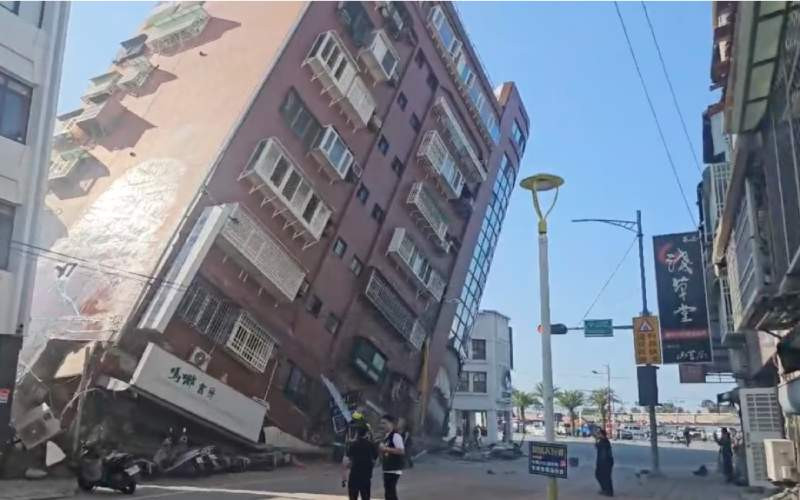
A partially collapsed building is seen in Hualien, eastern Taiwan on April 3, 2024. An earthquake rocked the island, collapsing buildings in a southern city and creating a tsunami that hit southern Japanese islands. [Via VOA]
A magnitude 7.2 earthquake shook Taiwan early Wednesday, causing massive power outages and the partial collapse of several buildings in eastern Taiwan. At least seven people died and more than 700 were injured.
The earthquake’s epicenter was located 25 kilometers off the island’s east coast, with a depth of 15.5 kilometers. Taiwan’s Central Weather Administration said the earthquake caused changes in water levels off the east coast and issued a tsunami warning. The alert was lifted around 11 a.m. local time.
Since the initial earthquake, which took place at 7:58 a.m. local time, more than 100 aftershocks have been detected. It was the strongest earthquake to have hit Taiwan in 25 years. At least 26 buildings have either completely or partially collapsed across Taiwan.
The earthquake caused damage across the island, with most serious cases concentrated in Hualien County in the east. More than a dozen buildings across the county have partially collapsed. While more than a dozen people have been rescued from two of the partially collapsed buildings in Hualien, at least one person is still trapped in the building.
Stunning images circulating on social media showed the first floor of one of the buildings in Hualien completely collapsed and the rest of the building tilted 45 degrees.
The earthquake has also caused rocks to fall along mountainous highways in central and eastern Taiwan, injuring people. At least 77 people remain trapped across Hualien county near the epicenter.
Authorities have temporarily closed off the Central Cross-Island Highway and the Suhua Highway, where some parts of the road sustained serious damage and injuries have been reported. The main railway and one of the bridges connecting Hualien to northern Taiwan suffered serious damages and the Ministry of Transportation hoped to resume railway traffic by Thursday.
The earthquake has forced Taiwan’s high-speed trains and metros in the three major cities - Taipei, Taichung, and Kaohsiung - to temporarily suspend operation. Following close evaluation, the Taipei metro and Taiwan high-speed rail resumed operation at a reduced capacity. In New Taipei City, at least 12 people have been evacuated from houses that experienced foundation subsidence.
Officials at semiconductor giant Taiwan Semiconductor Manufacturing Co. said they evacuated staff in parts of their plants, but the industrial safety system remained normal. The plant in Southern Taiwan Science Park remains operational.
Videos on social media showed books, plates, and other items falling from shelves in homes while people were seen opening doors and rushing outside.
Some Taiwan residents said Wednesday the earthquake was one of the strongest they’ve felt in many years.
“I jumped out of bed when the whole apartment began to shake and my first reaction was to open the door, grab my cat, and run out onto the street,” Alan Yang, a 36-year-old engineer in Taipei, told VOA by phone.
Others said the quake didn’t create too much interruption in their daily routines.
“I was attending a meeting when the whole building started to shake, but the speaker continued her lecture on the podium and no one around me was panicking,” Janice Tsai, a 30-year-old office worker, said in a phone interview.
Despite relative calm in many parts of Taiwan, Hualien County, near the epicenter, suspended schools and work for the day. Several schools in Taipei City ended classes early due to damaged buildings.
Amid the strongest earthquake in decades, many Taiwanese residents told VOA they didn’t receive the early warning message issued by the Central Weather Administration, raising questions about the effectiveness of Taiwan’s public warning system.
In response, the Central Weather Bureau said the system’s first two attempts to predict the magnitude of earthquake, which was 7.2, had underestimated the level of the earthquake, causing the public warning system to leave out some parts of Taiwan when it sent out earthquake alerts.
They vowed to improve the accuracy of the public warning system in the future.
The Central Disaster Response Center is coordinating disaster relief efforts across Taiwan while the military has been deployed to support local governments.The Central Weather Administration warned that aftershocks with a magnitude of 6.5 to 7 could take place in the next four days, urging people to stay vigilant.
Meanwhile, the Japan Meteorological Agency issued a Tsunami alert and evacuation advisory for coastal areas in the southwestern part of the Okinawa prefecture. At 9:18 a.m. local time, local authorities reported a 30-centimeter tsunami near Yonaguni Island, and two 20-centimeter tsunamis were also reported at nearby islands. The tsunami advisories were later lifted around noon local time in Japan.
In addition to Taiwan and Japan, the Philippines and parts of China also felt the impact of the earthquake. Chinese state media said several cities in the southern Fujian Province felt the quake.
Taiwan has long been troubled by earthquakes. In 1999, a magnitude 7.6 earthquake hit Taiwan and killed around 2,400 people.
 The Standard Group Plc is a multi-media organization with investments in media
platforms spanning newspaper print
operations, television, radio broadcasting, digital and online services. The
Standard Group is recognized as a
leading multi-media house in Kenya with a key influence in matters of national and
international interest.
The Standard Group Plc is a multi-media organization with investments in media
platforms spanning newspaper print
operations, television, radio broadcasting, digital and online services. The
Standard Group is recognized as a
leading multi-media house in Kenya with a key influence in matters of national and
international interest.



